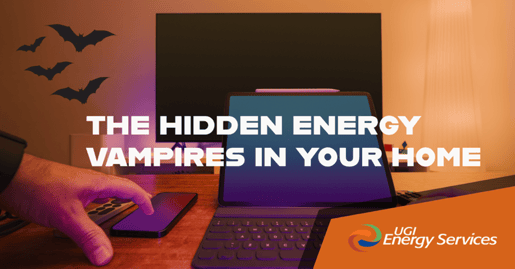This spooky season is a perfect time to take on energy vampires. Also known as phantom loads, energy vampires continue to draw electricity even when they’re turned off or in standby mode.

The term isn’t only a timely Halloween theme as these devices can haunt your energy bill all your long, quietly increasing your energy costs.
At UGI Energy Services, we believe energy conservation starts with greater awareness. So learn what you can do to take on energy vampires and reduce your energy use—and bills!
What Is an Energy Vampire?
An energy vampire is any device or appliance that continues to use electricity even when it’s not actively in use. According to data from the U.S. Department of Energy, these loads can account for up to 5–10% of a typical household's energy use.
Many modern electronics are designed to remain in a state of readiness: waiting for a remote signal, maintaining a digital clock, or running background updates. While this convenience may seem harmless, over time, the costs add up.
Common Energy Vampires in the Home
You may be surprised to learn how many everyday devices are constantly drawing power behind the scenes. Below are some of the most common offenders:
- Televisions and satellite boxes. Modern TVs, especially smart TVs, rarely ever turn completely off. Instead, they go into standby mode, ready to respond to a remote command. Cable or satellite boxes, like those with DVR capabilities, are notorious for drawing power 24/7, even when not recording or displaying content.
- Game consoles. Leaving your gaming console plugged in and connected to the internet? It’s likely consuming power, even if it’s “off.” Consoles often stay connected for automatic updates or quick-start functions.
- Computers and monitors. Desktop computers, monitors, and even printers tend to remain in standby or “sleep” mode, continuing to pull power when not in use. Screen savers also don’t reduce energy use; in fact, they may increase it.
- Kitchen appliances. Many appliances like microwaves, coffee makers, and toaster ovens feature digital clocks or displays. These minor functions require constant electricity to operate, even when the appliance isn’t in use.
- Smart home devices. Pay attention to smart speakers, thermostats, and Wi-Fi-enabled devices like light bulbs and smart plugs. While they can improve efficiency, they can also contribute to continuous energy draw.
Note, while devices drawing electricity are the primary energy vampires you’ll encounter, take note of your natural gas appliances as well, especially your natural gas fireplace. During warmer months, remember to turn the pilot light off.
How to Spot Energy Vampires
Not all energy users in your home are obvious. In fact, many of the most persistent energy vampires are designed to be discreet. They draw power in the background without you ever noticing. So how do you identify these stealthy energy drains?
Here are a few quick indicators:
- It has a remote control. If a device can be turned on with a remote, it’s likely using standby power.
- It displays lights or clocks when off. Think of your microwave or a plugged-in charger with a glowing indicator light.
- It has a "sleep" or "standby" mode. Many computers, game consoles, and smart TVs fall into this category.
- It’s warm to the touch. If a device feels warm even when it’s off, it could still be drawing power.
- It stays connected via Bluetooth or Wi-Fi. These wireless devices often require continuous power to maintain connectivity.
Simple Steps to Reduce Phantom Loads
The good news? Managing energy vampires doesn’t require a call to the Ghostbusters. Here are a few easy and effective strategies:
- Unplug devices when not in use. Physically unplugging devices can make a noticeable difference, especially with devices that aren’t used every day, like guest room TVs or rarely used kitchen gadgets.
- Use advanced power strips. Unlike traditional power strips, advanced or “smart” power strips detect when a device is in standby mode and automatically cut power. They’re especially helpful for home entertainment centers or office setups with multiple connected devices.
- Consolidate charging stations. Create a central location for all your chargers and unplug them when not actively in use. Consider using a power strip with a switch for quick on/off control.
- Adjust settings. Many electronics have built-in energy-saving settings. For example, set your computer to enter sleep mode after a short period of inactivity, or disable “instant-on” modes for TVs and gaming systems.
- Consider ENERGY STAR-certified devices. When upgrading appliances or electronics, look for the ENERGY STAR® label. These products meet strict efficiency guidelines and often have lower standby power usage.
Ready to Take Control of Your Energy Use?
Although the thought of energy vampires quietly adding to your electric bill can seem overwhelming, it doesn’t have to be. By taking steps to reduce phantom loads, you not only lower your monthly utility costs but also reduce your home’s overall energy footprint.
Whether you’re looking to improve energy efficiency or simply understand where your energy dollars are going, we’re here to help. Contact our team of energy experts to learn more about your energy consumption.




